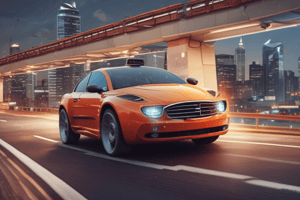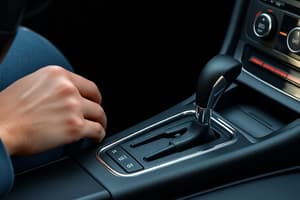Podcast
Questions and Answers
What was the primary finding regarding Group 2 while driving under high-traffic conditions?
What was the primary finding regarding Group 2 while driving under high-traffic conditions?
- They took much longer to press the brake. (correct)
- They did not press the brake at all.
- Their response time was the same as during low-traffic conditions.
- They pressed the brake faster than Group 1.
Which task resulted in the quickest response times according to the research on automated driving systems?
Which task resulted in the quickest response times according to the research on automated driving systems?
- Visual-vocal tasks.
- Non-driving related tasks.
- Visual-manual tasks.
- Auditory-vocal tasks. (correct)
How does talking to passengers compare to talking on a phone while driving?
How does talking to passengers compare to talking on a phone while driving?
- It promotes situational awareness due to shared awareness of surroundings. (correct)
- It has no impact on driving conditions.
- It is more distracting than talking on the phone.
- It has the same effect on driving performance.
What was identified as a potentially negative impact of a passenger during a drive?
What was identified as a potentially negative impact of a passenger during a drive?
According to the findings by Pouyakian et al. (2023), what was reported about the effects of conversations after they have concluded?
According to the findings by Pouyakian et al. (2023), what was reported about the effects of conversations after they have concluded?
What was the average reaction time for participants using a mobile phone in the study by Strayer and Johnson?
What was the average reaction time for participants using a mobile phone in the study by Strayer and Johnson?
According to Redelmeier and Tibshirani, how much does using a mobile phone increase the risk of a collision?
According to Redelmeier and Tibshirani, how much does using a mobile phone increase the risk of a collision?
What was the increase in reaction time observed in Caird et al.'s meta-analysis when participants used phones?
What was the increase in reaction time observed in Caird et al.'s meta-analysis when participants used phones?
What was one finding of Caird et al. (2014) regarding the impact of texting while driving?
What was one finding of Caird et al. (2014) regarding the impact of texting while driving?
What conclusion was made about the safety of hands-free devices in the context of driving?
What conclusion was made about the safety of hands-free devices in the context of driving?
How much additional distance does a 250 milliseconds delay in reaction time translate to while driving at 50mph?
How much additional distance does a 250 milliseconds delay in reaction time translate to while driving at 50mph?
Which of the following effects was most significant when participants were talking on the phone, according to Caird et al.?
Which of the following effects was most significant when participants were talking on the phone, according to Caird et al.?
What effect did increased texting while driving have on crash risk, according to Atwood et al.?
What effect did increased texting while driving have on crash risk, according to Atwood et al.?
What is the primary function of cognitive control as described?
What is the primary function of cognitive control as described?
What was the surprising finding regarding heavy media multitaskers?
What was the surprising finding regarding heavy media multitaskers?
What did the study by Loh and Kanai (2014) reveal about heavy multi-media multitaskers?
What did the study by Loh and Kanai (2014) reveal about heavy multi-media multitaskers?
What does the research suggest regarding the relationship between media multitasking and brain structure?
What does the research suggest regarding the relationship between media multitasking and brain structure?
What conclusion was drawn from the replication and meta-analysis by Wiradhany and Nieuwenstein (2017)?
What conclusion was drawn from the replication and meta-analysis by Wiradhany and Nieuwenstein (2017)?
What is defined as the ability to respond to multiple tasks simultaneously?
What is defined as the ability to respond to multiple tasks simultaneously?
What factor influences divided attention according to the content provided?
What factor influences divided attention according to the content provided?
What did Schneider and Shiffrin (1977) demonstrate regarding practice?
What did Schneider and Shiffrin (1977) demonstrate regarding practice?
In McCleod's study, what types of tasks led to increased errors when performed concurrently?
In McCleod's study, what types of tasks led to increased errors when performed concurrently?
What does the term 'supertaskers' refer to in multitasking?
What does the term 'supertaskers' refer to in multitasking?
According to later experiments, what occurs when both target and distractors are similar?
According to later experiments, what occurs when both target and distractors are similar?
How does task difficulty impact divided attention?
How does task difficulty impact divided attention?
Which of the following best describes multitasking?
Which of the following best describes multitasking?
What is the primary effect of mobile phone usage on pedestrians, according to the findings?
What is the primary effect of mobile phone usage on pedestrians, according to the findings?
What does the term 'switching cost' refer to in task switching?
What does the term 'switching cost' refer to in task switching?
Which characteristic is NOT associated with individuals who are attracted to multitasking?
Which characteristic is NOT associated with individuals who are attracted to multitasking?
According to the OFCOM report, what significant trend was observed among 13-17-year-olds?
According to the OFCOM report, what significant trend was observed among 13-17-year-olds?
What was the main method used in the Ophir et al. (2009) study?
What was the main method used in the Ophir et al. (2009) study?
What is a common misconception about multitasking?
What is a common misconception about multitasking?
Which group is more likely to believe they are proficient at multitasking?
Which group is more likely to believe they are proficient at multitasking?
What negative impact can multitasking have, as highlighted in the content?
What negative impact can multitasking have, as highlighted in the content?
What was the effect of mobile device presence on feelings of interpersonal connectedness during conversations?
What was the effect of mobile device presence on feelings of interpersonal connectedness during conversations?
What percentage of participants were identified as supertaskers in the multitasking study?
What percentage of participants were identified as supertaskers in the multitasking study?
Which of the following was NOT considered a dependent variable in the study of mobile device presence?
Which of the following was NOT considered a dependent variable in the study of mobile device presence?
What was the common belief held by many individuals regarding multitasking?
What was the common belief held by many individuals regarding multitasking?
In the multitasking study, which measure showed a typical performance decrement in dual-task conditions?
In the multitasking study, which measure showed a typical performance decrement in dual-task conditions?
How often are employees typically distracted while using a computer for work?
How often are employees typically distracted while using a computer for work?
What was the impact of mobile devices on the quality of conversation ratings?
What was the impact of mobile devices on the quality of conversation ratings?
What percentage of students accessed unrelated web pages while attending class?
What percentage of students accessed unrelated web pages while attending class?
Which aspect of multitasking is emphasized as affecting productivity negatively?
Which aspect of multitasking is emphasized as affecting productivity negatively?
What was shown to suffer in dual-task performance according to the multitasking study?
What was shown to suffer in dual-task performance according to the multitasking study?
Flashcards
Divided Attention
Divided Attention
The ability to focus your attention on multiple tasks or demands at the same time.
Task Switching
Task Switching
The process of switching between different tasks, often requiring mental effort and time.
Multimedia Multitasking
Multimedia Multitasking
The use of multiple media forms simultaneously, like watching TV and browsing the internet.
Supertaskers
Supertaskers
Signup and view all the flashcards
Practice and Divided Attention
Practice and Divided Attention
Signup and view all the flashcards
Task Difficulty and Divided Attention
Task Difficulty and Divided Attention
Signup and view all the flashcards
Task Similarity and Divided Attention
Task Similarity and Divided Attention
Signup and view all the flashcards
Mobile Phones and Driving
Mobile Phones and Driving
Signup and view all the flashcards
Mobile Phone Use and Reaction Time
Mobile Phone Use and Reaction Time
Signup and view all the flashcards
Mobile Phone Use and Collision Risk
Mobile Phone Use and Collision Risk
Signup and view all the flashcards
Hands-Free vs. Handheld Phones
Hands-Free vs. Handheld Phones
Signup and view all the flashcards
Phone Use and Reaction Time (Meta-Analysis)
Phone Use and Reaction Time (Meta-Analysis)
Signup and view all the flashcards
Texting While Driving
Texting While Driving
Signup and view all the flashcards
Reading vs. Typing Text Messages
Reading vs. Typing Text Messages
Signup and view all the flashcards
Prevalence of Texting While Driving
Prevalence of Texting While Driving
Signup and view all the flashcards
Voice-Operated Systems
Voice-Operated Systems
Signup and view all the flashcards
Switching Cost
Switching Cost
Signup and view all the flashcards
High Sensation Seeker
High Sensation Seeker
Signup and view all the flashcards
Multitasking Perception
Multitasking Perception
Signup and view all the flashcards
Approach-Oriented
Approach-Oriented
Signup and view all the flashcards
Focus Difficulty
Focus Difficulty
Signup and view all the flashcards
Conversation with passenger vs Phone call
Conversation with passenger vs Phone call
Signup and view all the flashcards
Hands-free phone use
Hands-free phone use
Signup and view all the flashcards
Automated driving and non-driving tasks
Automated driving and non-driving tasks
Signup and view all the flashcards
Passenger's role in driving
Passenger's role in driving
Signup and view all the flashcards
After-conversation effects
After-conversation effects
Signup and view all the flashcards
Cognitive Control
Cognitive Control
Signup and view all the flashcards
Heavy Media Multitaskers
Heavy Media Multitaskers
Signup and view all the flashcards
Task-Switching Difficulty
Task-Switching Difficulty
Signup and view all the flashcards
Anterior Cingulate Cortex (ACC)
Anterior Cingulate Cortex (ACC)
Signup and view all the flashcards
The iPhone Effect
The iPhone Effect
Signup and view all the flashcards
Mobile Phones & Social Interaction
Mobile Phones & Social Interaction
Signup and view all the flashcards
Mobile Phone Presence
Mobile Phone Presence
Signup and view all the flashcards
Empathy & Mobile Phone Usage
Empathy & Mobile Phone Usage
Signup and view all the flashcards
Phone Presence in Close Relationships
Phone Presence in Close Relationships
Signup and view all the flashcards
Meaningful Conversations & Phone Presence
Meaningful Conversations & Phone Presence
Signup and view all the flashcards
Mobile Phone Usage Prevalence
Mobile Phone Usage Prevalence
Signup and view all the flashcards
Supertaskers (Driving & Cognitive Task)
Supertaskers (Driving & Cognitive Task)
Signup and view all the flashcards
Multitasking Performance Decline
Multitasking Performance Decline
Signup and view all the flashcards
Multitasking & Productivity
Multitasking & Productivity
Signup and view all the flashcards
Multitasking in Learning
Multitasking in Learning
Signup and view all the flashcards
Study Notes
Multitasking
- Multitasking is performing two or more tasks simultaneously.
- Learning objectives focus on understanding divided attention, empirical work on mobile phones and driving/walking, task switching, multimedia multitasking, and whether multitasking is beneficial. Supertaskers are also discussed.
Divided Attention
- Divided attention is the ability to respond to multiple tasks or demands at the same time.
- Factors like task difficulty and task similarity affect divided attention.
Practice
- Schneider and Shiffrin (1977) demonstrated the impact of practice on multitasking.
- Participants were shown a target stimulus, followed by a rapid series of test frames.
- The task required retaining the target in memory and checking if it appeared in the test frames.
- Performance improved with practice, eventually reaching automaticity after about 600 trials.
Task Difficulty
- Task difficulty influences divided attention.
- More challenging tasks make multitasking more difficult.
Task Similarity
- Similar tasks are harder to perform concurrently (multitask).
- McLeod (1977) demonstrated this effect.
Mobile Phones and Driving
- Strayer and Johnson (2001) found that using a mobile phone significantly decreased reaction time and increased missed red lights in a driving simulation.
- Phone use impacts driving, whether hand-held or hands-free.
- Redelmeier and Tibshirani (1997) showed a quadruple increase in collision risk for drivers using a mobile phone.
- Caird et al. (2008) found that reaction times increased by 250 milliseconds when participants used phones.
Typing and Driving
- Typing and reading text messages negatively impacted eye movements, stimulus detection, reaction time, collisions, and driving performance.
- Studies show that texting and driving significantly increases collision risk.
Driving and Phone Use
- Strayer et al. (2003) studied the effect of phone use on driving in traffic simulations.
- Results showed that hands-free phone use could still impair performance, particularly in complex or high-traffic situations.
- Other studies also indicate that conversations or the usage of phone functions impacts driving negatively.
Automated Driving Systems
- Wanda et al. (2018) investigated response times to critical tasks while driving in highly automated systems, and during non driving related tasks.
- Response times were longer when the non-driving task was visual-vocal or visual-manual, e.g., reading or writing text messages.
Talking to Passengers
- Conversations with passengers can be different than conversations on phones.
- Context impacts the complexity of a conversation, which might decrease the potential for negative effects on the driver.
- Conversations with passengers can often lead to more situational awareness and could decrease driver distraction risk.
- Studies have shown differences in attention, distraction, and performance based on types of conversations and passengers.
- Hyman et al. (2010) studied walking behavior and conversations while using phones, showing poor performance in both tasks.
Task Switching
- Task switching involves shifting attention between different tasks.
- Switching costs include slower performance and decreased accuracy.
- Using a phone, in particular, causes greater switching costs.
Multimedia Multitasking
- OFCOM (2021) report showed increased online activity, including the use of multiple devices/media at once (i.e., phone and TV).
- Ophir et al. (2009) studied individuals high and low in multimedia multitasking levels/frequency and found reduced cognitive control in heavy multitaskers.
- The study indicated worse task-switching abilities with heavy multitaskers.
The iPhone Effect
- 200 participants took part in a study where conversation quality was measured to see how mobile phones might impact real-life interactions.
- Presence of a phone reduced interpersonal connectedness.
- Also studied if the type of conversation affected interpersonal connectedness and how phone use impacted conversation quality.
Supertaskers
- Individuals with exceptional multitasking skills show a pattern related to other studies, and were studied using specific tests.
- Watson and Strayer (2010) used the OSPAN task and driving simulations to measure multitasking abilities in a study.
- Performance was markedly inferior when multitasking.
- Multitasking decreased performance in a variety of tasks.
Studying That Suits You
Use AI to generate personalized quizzes and flashcards to suit your learning preferences.
Related Documents
Description
Explore the findings from recent studies on automated driving systems and the effects of communication while driving. This quiz covers various aspects including response times, risks associated with mobile phone usage, and the role of passengers during drives. Test your knowledge on how these factors influence driving safety.




